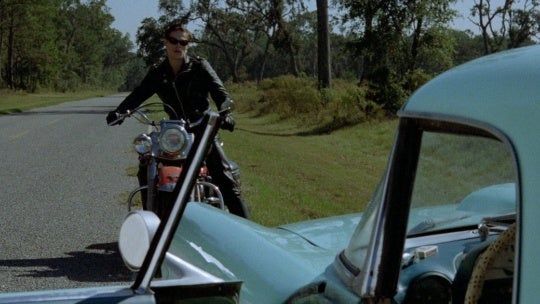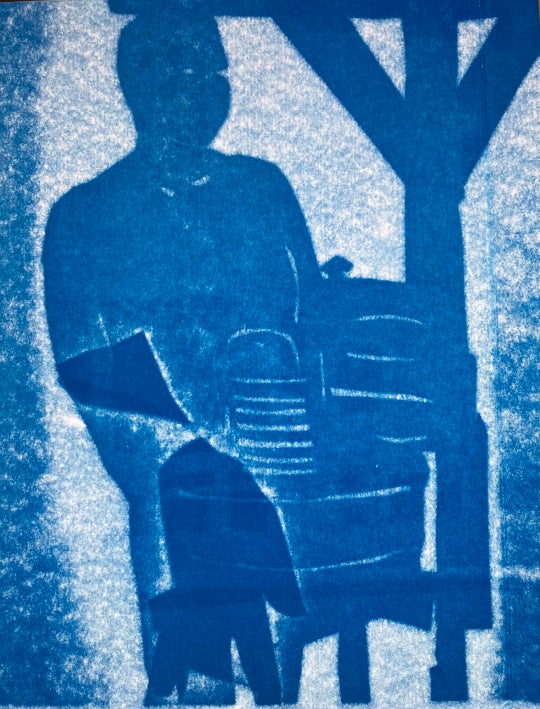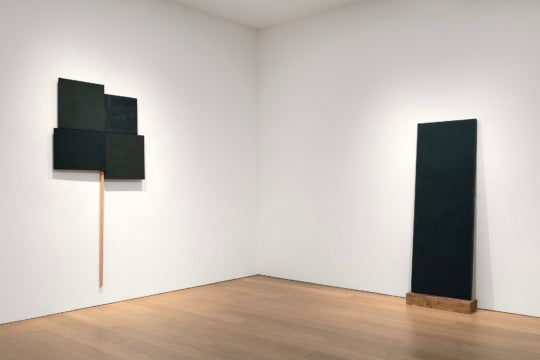
Rocío Rodríguez offers a rough timeline of the past 100 years of abstraction in her show “Small Works” at Sandler Hudson.
Consisting of over 30 paintings and drawings, the show divides in half, with works on paper hung conventionally, and a works on canvas and panel hung salon style. Straightaway, the modest size and neutral-toned forms in paintings like The Leftovers and January 27, 2015 bring Giorgio Morandi to mind. The way these loosly defined blocks of color nestle together like a still-life painting are reminiscent of this modernist precursor who, spent a career painting tender reductive still-lifes consisting of bottles, bowls, pitchers, and other tableware. Rodríguez, too, is a reductive painter. Her objects of depiction are limited to various rectilinear forms consisting of hard-edge squares, scumbled rectangles, flat blocks of color, and cubes of thick impasto. All of these elements are illustrated in an endless variety of solidity and erasure — sometimes stacked on top of each other, sometimes fall off one another, sometimes living directly on the surface, and sometimes glazed over and pushed deep into the background.

But allusions to still life or representation give way to high modernist painting when the forms are suspended in the middle of the paintings, seemingly in mid air rather than balanced on a kitchen table like in a Morandi. Paintings such as Desert Plinth and March 27, 2015 are much more reminiscent of the 1950 Hans Hoffman and Philip Guston. Here, the component parts hang in an amorphous zone, and the painted gestures are used to compose the picture as a whole. The brush marks appear literal rather than representative of an independent entity.

In her most articulate and impactful paintings, the forms are positioned in relationship to one another in such a manner that they elucidate a narrative, sometimes jostling, nuzzling, melding, or tearing each other apart. The blocks are painted distinctively, imbuing the shape with a personality, emotional state, and/or cognition. In the 1990s, Jonathan Lasker coined the term “figural” to describe his abstract paintings that clearly described human interaction. I could not help but think of Lasker while seeing paintings such as Red Sitting on Pink and August 18, 2015.

Even while using a limited set of shapes, Rodríguez brings such wide-ranging painting techniques to bear that nearly a century of painting is referenced. The easy citation of past trendsetters makes for a show that risks appearing redundant. And it’s true these paintings seem familiar. Yet, it’s also clear these paintings do not operate on innovation. Instead, the obvious concern is a thoughtful expression of the human condition. By this I mean, Rodríguez’s blocks of painted form operate like characters in a play. Sometimes the character appear stable and firm and in others they are tentative or damaged. They move from the foreground to the background, dance with each other and fight with each other. They exude a full range of emotion and demonstrate how circumstance or context can impact the appearance of a character. And like our experience of theater, the themes on display have been tackled by centuries of precursors, but the concern for the viewer is whether or not the story and characters are believable. The authentic expressive quality of Rodríguez’s paintings is what makes them so successful.
Brendan Carroll is a painter living in Atlanta.




